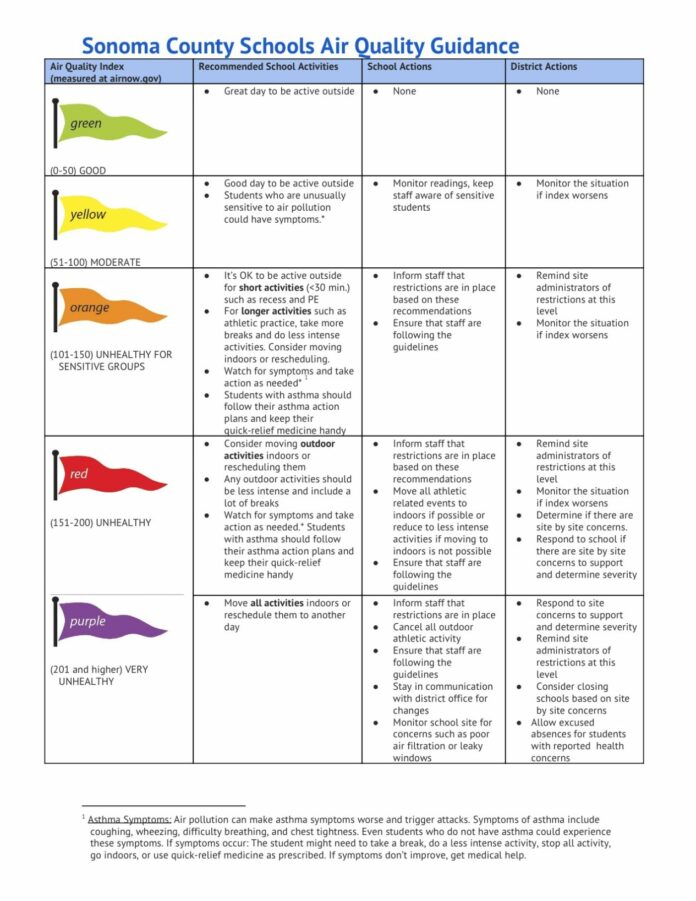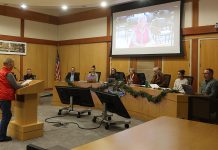The Sonoma County Office of Education (SCOE) has updated the air quality guidelines that school districts developed and released last fall in response to the smoke from the Camp Fire.
When thick smoke blanketed the county, individual districts were left scrambling to decide what to do, and parents and other stakeholders were often left unhappy with the decisions made.
In response to that uncertainty, school districts have been working over the last few months to update the guidelines. They were developed in collaboration with the North Sonoma County Air Pollution Control District, Bay Area Air Quality Management District, the county’s Department of Public Health and SCOE.
“This is a complex issue and we believe the best long-term solution is to have statewide guidelines developed by state-level experts from the EPA, Air Resources Board and other agencies. SCOE has been and is continuing to advocate for this,” said Jaime Hansen, director of communications for SCOE in an email. “These updated guidelines are meant to be used in the meantime, and are best thought of and described as a living document that can change as new information becomes available. We wanted to share them now, in advance of next year’s fire season.”
These guidelines were modified from Environmental Protection Agency (EPA) and Centers for Disease Control and Prevention’s “Air Quality and Outdoor Activity Guidance for Schools and Wildfire Smoke: A Guide for Public Health Officials.”
According to a statement from SCOE, they are meant to “assist school districts in making decisions when air quality is poor” but that “school closure is ultimately a district-by-district decision based on local conditions.”
It can be challenging to determine safety, because the impact of smoke depends on the sensitivity of the person and the length of exposure.
Children are considered more sensitive because their developing lungs and heightened activity make them more sensitive to the impacts of smoke.
According to the new guidelines, school districts will monitor the air quality index (AQI) using EPA’s AQI monitoring tools at AirNow.gov. School activities/closures decisions will be made based on AirNow measurements and local conditions, such as the availability/quality of air filtration and direct observation of indoor/outdoor air quality.
AirNow.gov is a network of monitors that form a network to track regional air quality. According to experts with local air quality management districts, pollutants like smoke tend to be well-mixed in the atmosphere and are adequately represented by these monitors, even if a monitor is not in the same neighborhood as a school.
AirNow is regularly monitored for quality control by the EPA and remains accurate at all levels as opposed to personal sensors like Purple Air, which often overestimate — especially at AQI of 150 or higher — according to a statement from SCOE.
School districts must report any school closures to SCOE for media notification and school districts will announce any closures to families using normal school closure procedures.
Children with respiratory or heart conditions are vulnerable to poor air quality and may require extra precautions. Therefore, school districts should advise parents to consult with their family health care provider.
SCOE has also added to their guidelines concerning the use of masks. According to SCOE, there is insufficient data to support the benefit of prolonged use of N95 respirators in wildfire smoke events.
In addition, N95 respirator masks are designed for professional use by trained adults and are not intended for children. Therefore, masks are not recommended for children by most air quality districts/public health agencies.
N95 masks require a perfect seal to be effective. They can give a false sense of security without a proper fit. Also, N95 masks may be dangerous for certain persons with lung or heart conditions and may lead to increased heart rate, respiratory rate and/or labored breathing.
Finally, masks must be kept clean and replaced frequently to be effective.
It is recommended that districts install and maintain HVAC air conditioning systems with high-quality air filters that have medium or high efficiency, install portable HEPA air filters in classrooms where possible and ensure doors and windows are sealed tightly to minimize air movement in and out of rooms.









